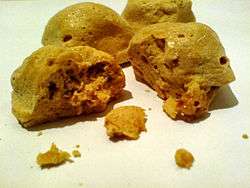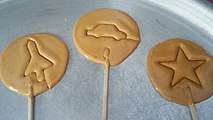Honeycomb toffee
 | |
| Alternative names | Sponge toffee, cinder toffee, seafoam, golden crunchers, hokey pokey |
|---|---|
| Type | Toffee |
| Main ingredients | Brown sugar, corn syrup (or molasses or golden syrup), baking soda |

Honeycomb toffee, sponge toffee, cinder toffee or hokey pokey is a sugary toffee with a light, rigid, sponge-like texture. Its main ingredients are typically brown sugar, corn syrup (or molasses or golden syrup in the Commonwealth of Nations) and baking soda, sometimes with an acid such as vinegar. The baking soda and acid react to form carbon dioxide which is trapped in the highly viscous mixture. When acid is not used, thermal decomposition of the baking soda releases carbon dioxide. The lattice structure is formed while the sugar is liquid, then the toffee sets hard. The candy goes by a variety of names and regional variants.
Owing to its relatively simple recipe and quick preparation time, in some regions it is often made at home, and is a popular recipe for children. It is also made commercially and sold in small blocks, or covered in chocolate, a popular example being the Crunchie bar.
Regional names
Honeycomb toffee is known by a wide variety of names including:
- cinder toffee in Britain[1] "Cinder toffee" is also used to refer to brittle treacle toffee. Yellowman in Northern Ireland is very similar to honeycomb toffee.
- fairy food candy or angel food candy in Wisconsin, United States[2]
- hokey pokey in New Zealand[3][4][5][6] (especially in the Kiwi classic Hokey Pokey ice cream).
- honeycomb in South Africa, Australia, Britain[7], and Ireland
- old fashioned puff in Massachusetts[8]
- puff candy in Scotland[9]
- sea foam in Maine, Washington, Oregon, Utah, California and Michigan, United States
- sponge candy in Milwaukee, Wisconsin, St. Paul, Minnesota, Western New York, and Northwest Pennsylvania, United States[10]
- sponge toffee ("tire éponge") in Canada[11]
In various cultures
China
In China it is called 蜂窝糖. It is said to be a popular type of confectionery among the after-80s in their childhood.
Hungary
In Hungary, it is known as törökméz (Turkish honey) and is commonly sold at town fairs.
Japan
The same confection is a traditional sweet in Japan known as karumeyaki (カルメ焼き), a portmanteau of the Portuguese word caramelo (caramel) and the Japanese word yaki (to bake). It is typically hand-made, and often sold by street vendors.
Korea
| Korean name | |
| Hangul | 달고나 |
|---|---|
| Revised Romanization | dalgona |
| McCune–Reischauer | talgona |
| IPA | [tal.ɡo.na] |
| Hangul | 뽑기 |
| Revised Romanization | ppopgi |
| McCune–Reischauer | ppopki |
| IPA | [p͈op̚.k͈i] |
Dalgona (달고나) or ppopgi (뽑기) is a Korean candy made with melted sugar and baking soda.[12][13] It was a popular street snack in the 1970s and 1980s, and is still eaten as a retro food.[14] When a pinch of baking soda is mixed into melted sugar, thermal decomposition of the baking soda releases carbon dioxide, which makes the liquidized sugar puff up, and it becomes a light and crunchy candy once cooled and hardened.[15] Typically, the creamy beige liquid is poured on a flat surface, pressed flat, and stamped with a patterned mold. Eaters try to trim their way around the outline or picture on the snack without breaking the picture.[15] If the trimming is completed successfully without breaking the candy, the consumer receives another free dalgona.[15]
 Dalgona
Dalgona Making dalgona on yeontan (coal briquettes)
Making dalgona on yeontan (coal briquettes)
See also
References
- ↑ Connelly, Andy (2010-09-24). "The science and magic of cinder toffee | Andy Connelly | Science | guardian.co.uk". Guardian. Retrieved 2012-01-05.
- ↑ "Two local chocolate makers battle over use of 'fairy food'". JSOnline.com. December 22, 2011. Retrieved 6 December 2013.
- ↑ "Papers Past — Evening Post — 19 December 1927 — THE TRUANT STAR". Paperspast.natlib.govt.nz. 1927-12-19. Retrieved 2012-01-05.
- ↑ Chelsea's team of cooks, added 25 May 2011 (2011-05-25). "Chelsea Sugar - Hokey Pokey". Chelsea.co.nz. Retrieved 2012-01-05.
- ↑ "Hokey Pokey - New Zealand Kids Recipe at KiwiWise". Kiwiwise.co.nz. Retrieved 2012-01-05.
- ↑ "Popular Kiwi recipes – pavlova, anzac biscuits, roast lamb, pikelets etc". Kiwianatown.co.nz. Retrieved 2012-01-05.
- ↑ "Food - Honeycomb recipes". BBC. Retrieved 2012-01-05.
- ↑ "Hill Top Candy". hilltop candy.com. 2015. Retrieved 6 March 2014.
- ↑ S.W.R.I. (1977). S.W.R.I. Jubilee Cookery Book. Edinburgh: Scottish Women's Rural Institutes; Reprint of 8th Edition (1968), p179
- ↑ "Sponge Candy: Chocolate, With a Center of Honeycomb". BuffaloChow.com. January 1, 2008. Archived from the original on December 31, 2008. Retrieved 13 January 2010.
- ↑ "Sponge Toffee Recipe". CanadianLiving.com. Fall 2009. Retrieved 6 March 2014.
- ↑ AsiaToday (31 January 2017). "Korean Cuisine Introduced at JNU International Food Festival". Huffington Post. Retrieved 5 July 2017.
- ↑ Cho, Chung-un (24 February 2017). "[Eye Plus] Forgotten past relived at Tongin Market". The Korea Herald. Retrieved 5 July 2017.
- ↑ Seoul Metropolitan Government (2010). Seoul Guide Book. Seoul: Gil-Job-E Media. p. 150.
- 1 2 3 Sohn, Ji-young (3 December 2015). "Creative, eye-catching goods available at Seoul Design Market". The Korea Herald. Retrieved 5 July 2017.